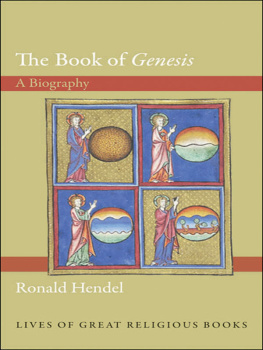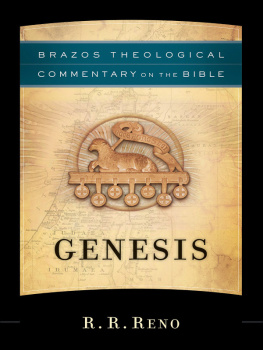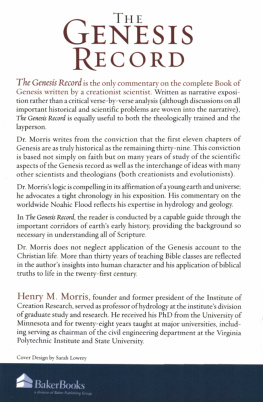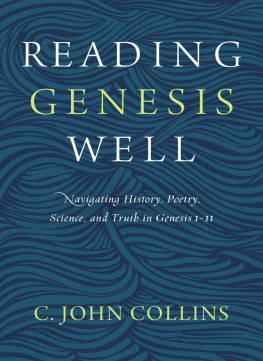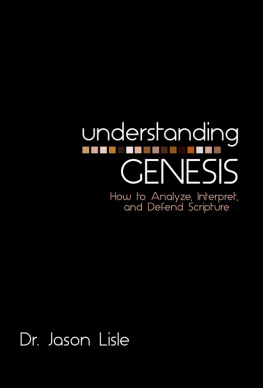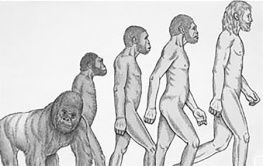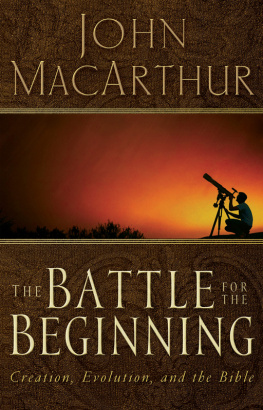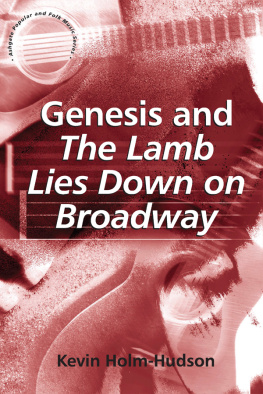
LIVES OF GREAT RELIGIOUS BOOKS
The Book of Genesis
LIVES OF GREAT RELIGIOUS BOOKS
The Dead Sea Scrolls, John J. Collins
The Book of Mormon, Paul C. Gutjahr
The Book of Genesis, Ronald Hendel
The Tibetan Book of the Dead, Donald S. Lopez, Jr.
Dietrich Bonhoeffers Letters and Papers from Prison, Martin E. Marty
The I Ching, Richard J. Smith
Augustines Confessions, Garry Wills
FORTHCOMING:
The Book of Exodus, Jan Assmann
Confuciuss Analects, Annping Chin and Jonathan D. Spence
The Bhagavad Gita, Richard H. Davis
Josephuss Jewish War, Martin Goodman
John Calvins Institutes of the Christian Religion, Bruce Gordon
The Book of Common Prayer, Alan Jacobs
The Book of Job, Mark Larrimore
The Lotus Sutra, Donald S. Lopez, Jr.
Dantes Divine Comedy, Joseph Luzzi
C. S. Lewiss Mere Christianity, George Marsden
Thomas Aquinass Summa Theologiae, Bernard McGinn
The Greatest Translations of All Time: The Septuagint and the Vulgate, Jack Miles
The Passover Haggadah, Vanessa Ochs
The Song of Songs, Ilana Pardes
Rumis Masnavi, Omid Safi
The Yoga Sutras of Patanjali, David Gordon White
The Book of Genesis
A BIOGRAPHY
Ronald Hendel
PRINCETON UNIVERSITY PRESS
Princeton and Oxford
Copyright 2013 by Princeton University Press
Published by Princeton University Press, 41 William Street, Princeton, New Jersey 08540
In the United Kingdom: Princeton University Press, 6 Oxford Street, Woodstock, Oxfordshire OX20 1TW
press.princeton.edu
Jacket Illustration: Catholic Church.[Psalter-Hours of Guiluys de Boisleux].[Arras, France, 1243 1246], MS M.730, fol. 9r. Courtesy of The Pierpont Morgan Library, New York. MS M.730, fol. 9r. Purchased from the Holford Estate, 1927.
All Rights Reserved
Library of Congress Cataloging-in-Publication Data
Hendel, Ronald S.
The book of Genesis : a biography / Ronald Hendel.
p. cm. (Lives of great religious books)
Includes bibliographical references and index.
ISBN 978-0-691-14012-4 (alk. paper)
1. Bible. O.T. GenesisCriticism, interpretation, etc. I. Title.
BS1235.52.H46 2013
222.1106dc23 2012015634
British Library Cataloging-in-Publication Data is available
This book has been composed in Garamond Premier Pro
Printed on acid-free paper.
Printed in the United States of America
10 9 8 7 6 5 4 3 2 1
For Bob Alter, friend, colleague, and fellow Genesiologist
Not to outgrow Genesis, is a sweet monition.
EMILY DICKINSON
CONTENTS
INTRODUCTION
The Life of Genesis
CHAPTER 1
The Genesis of Genesis
CHAPTER 2
The Rise of the Figural Sense
CHAPTER 3
Apocalyptic Secrets
CHAPTER 4
Platonic Worlds
CHAPTER 5
Between the Figure and the Real
CHAPTER 6
Genesis and Science: From the Beginning to Fundamentalism
CHAPTER 7
Modern Times
AFTERWORD
Stories of Our Alley
ACKNOWLEDGMENTS
This book owes its birth to many hands. My thanks to Fred Appel for inviting me to contribute a volume to the Lives of Great Religious Books. Since the life of Genesis is so vast, I did what professors doI designed a course. My thanks to the delightful and inquisitive Berkeley undergraduates who have taken this course (The Bible in Western Culture), which is now my favorite offering. Their questions have pushed me to explore things deeply, for which I am grateful. Thanks also to my excellent teaching assistants, Daniel Fisher, Alison Joseph, and Dale Loepp. I relied on many of my faculty colleagues to bring me up to speed on topics ancient, medieval, and modern. Several of them generously commented on drafts of chapters: Steve Justice, Niklaus Largier, Tony Long, Chessie Rochberg, and Jonathan Sheehan. Bob Alter, to whom this book is dedicated, vetted the whole manuscript (and must have noticed his influence in several parts). Yosefa Raz, my research assistant, provided invaluable comments on style and content. With these superb advisors, any flaws in conception and execution are my own stubborn fault. Jodi Beder bravely tamed my prose. Janet Russell contributed an exemplary index. Bill Propp not only improved my text but, to my delight, conjured seven marvelous illuminations (located at the head of each chapter). Finally, my thanks to Ann, Ed, and Nat, who may actually end up reading this book.
LIVES OF GREAT RELIGIOUS BOOKS
The Book of Genesis
The Life of Genesis
INTRODUCTION
Despite predictions of its demise, the book of Genesis is still alive and well in the twenty-first century. From political and religious debates to consumer culture, Genesis is all around us. One has only to glance at the headlines to find controversies that take their heat and light from Genesis. The question of whether the contents of Genesis 1 should be taught in science classesunder the names creationism or intelligent designpreoccupies school boards and political candidates. Proponents and opponents of gay marriage and gay clergy appeal to the testimony of Genesis. The new atheist writers criticize the irrationality of Genesis, much as the old atheists, like Thomas Paine, did more than two centuries ago. Evangelical scholars argue whether Adam and Eve were historical figures.
In our popular and commercial culture, references to Genesis pop up regularly. Jacobs Ladder is an upscale exercise machine, priced around $3,000. Am I My Brothers Keeper is the name of an album by the hip-hop group Kane and Abel. The Methuselah Foundation supports scientific research into extending human life. Adam and Eve is the name of a sex toy company. Examples of such creative branding could be multiplied indefinitely. Recently an illustrated version of Genesis, by the comics icon R. Crumb, topped the New York Times best-seller list. A favorite tourist destination, the Creation Museum (built in Kentucky by a group called Answers in Genesis), has attracted over a million visitors. This modern shrine to Genesis features high-tech dioramas of the Garden of Eden and Noahs Ark, complete with dinosaurs, a well-muscled Adam, and a supermodel Eve. In its halls Genesis becomes a simulacrum of science, providing comfort for its target audience.
In earlier centuries Genesis was alive in different ways. In the Middle Ages ascetics and mystics tried to gain access to the heavenly Garden of Eden through spiritual exercises. The stories of Genesis were reproduced in illustrations in stained-glass windows and paupers Bibles. Monks and nuns chanted sublime songs dedicated to the patriarchs. Figs and apples, identified as the forbidden fruit in the Garden of Eden, were eaten as aphrodisiacs. Christians made pilgrimages to great cathedrals and shrines, where they could still perceive the aura of Genesis and its famous events. Although most people could not read the book, the evidence of Genesis was everywhere.
For roughly two and a half thousand years, people in Western culture have been living cheek by jowl with the book of Genesis. It is this mutual engagementin which Genesis colors our lives, while we strain to understand itthat is the subject of this book. Within the large scope of the life of Genesis, three interwoven themes animate our story: (1) The life of Genesis involves an interplay between its original meaningsits plain sensesand its multiple forms of interpretation over the centuries. (2) The life of Genesis involves an ages-long relationship between truth and error, in which the boundaries between the two are fiercely contested. (3) The keys to understanding the book of Genesis in every age correspond to the keys to understanding reality generally. But these keys change over time, and they open different doors. Let us explore these themes and their implications.
Next page
